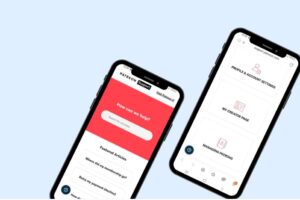Now even a small company is hard to imagine without an online store. People are used to the fact that any thing can be bought from home. Online trading is convenient, fast, and profitable. But eCommerce will not replace traditional shopping: people love to shop.
We buy according to our mood: it’s sometimes more convenient to buy online, and other times it’s more convenient to hold the item in your hands. Retailers must keep in mind that retail and e-commerce are connected. Give purchasers both of these tools at the same time, and sales will skyrocket.
How the app can help your retail business
Online shopping apps are the best way to combine retail and online: they are always at hand, and their functionality is limited only by your imagination (and budget).
To understand what apps can do for retail, you need to think about what the customer wants. And then develop your application only around what you have identified. If the buyer wants a new phone, he will only look for it in the application in the tab with phones of a certain brand, if the student wants his homework done, he will use the site writeanypapers.com, which specializes only in this.
The first is a good deal. Would you turn down a discount card carefully presented to you by your neighbor in line at the checkout if you didn’t have one? Or perhaps a mail-in discount coupon? We all want to receive a better deal on a product than we can get in the shop, so keep that in mind while thinking about your customers.
The second is “transparent” shopping. We want to know everything about the product: weight, size, material, country of manufacture, expiration date, random facts. We are especially interested in the opinions of people who have already bought the product and are willing to tell the whole truth about it.
The third is a quick purchase. It is necessary to take into account not how many hours the buyer spent in the store, but how quickly he managed to complete the purchase when he was tired and wanted to go home. From the decision of the client to leave the store until the moment of payment, a minimum amount of time must pass so that the person does not have an unpleasant aftertaste from going to the store.
All of these customer needs can be met with a mobile app (and even do a little more).
How an online store app sells offline
- Product preview in the app.
In a store, a buyer may encounter a situation where the product he wants to buy does not have a sample on display. The seller can’t break the packaging of unpaid goods, so the buyer has to either leave with nothing or buy at his own risk.
In-app previews are an alternative path that customers would choose if you gave them this option. The product card and feedback from other customers will help them make an informed purchase decision and not be disappointed.
Previews are not limited to photos and promo videos – developers can incorporate augmented reality technology into the mobile app, so the customer can see how the product will look in the physical world.
- Scan codes for more information.
The online store application will help the buyer to find out more details about the product without contacting a consultant. The user just needs to point the camera at a barcode or QR code, and the application will show him additional information about the product: a card, price, colors, the remaining quantity of the product, reviews – in general, everything that does not fit on the price tag.
Thanks to this function, the salesperson reduces the workload of consultants. It is especially convenient to use code scanning in large shopping centers and hypermarkets, where it is difficult to find free staff.
- Payment for goods in the mobile app.
The app allows you to place an order and pay for it online, with the buyer merely having to come to the store to pick it up. However, if the customer is already in the store and the items in his basket have not yet been paid for, you can reverse the process: transform the mobile app into an “online checkout” so that customers do not have to wait in long queues.
The buyer can scan the items in the cart, pay for them using Google or Apple Pay, and go on to other businesses. This feature will save you time (and nerves).
- Loyalty program for app users.
A loyalty program is a tool that can help you create great customer relationships that your store most likely already has.
But the main question is the question of format. Ordinary discount and loyalty cards have already become a habit – only their absence can surprise the buyer. If you replace a card with a mobile app, your customers will have access to more discounts, which means more opportunities to spend money.
The functionality of the apps is not limited to the accumulation of points and a fixed discount – which means that you can manage customer behavior. How – depends on your imagination.
Both buyers and sellers will benefit from the application’s personal offer system. If the user agrees to disclose personal information, such as search history, the app analyzes his preferences and only shows him things that he is interested in.
Implementing a loyalty program can be a big and expensive project, but experience shows that it pays for itself.
- Notifications and geo-pushes as an invitation to buy.
With the help of geolocation and notifications, the app is able to influence the user’s purchasing decision.
The gap between buyer and seller is literally cut in half thanks to geolocation. If the user is near the store, the app sends push notifications about special offers and discounts, inviting him to come in. Such advertisements are usually time-limited: “Today only” or “Product of the day.” Users understand that if they don’t react now, they would forever miss out on a wonderful deal.
Small sensors hidden in the store provide different signals to the app while the user is in the store. If a consumer stands near a product for an extended period of time and is unable to make a decision, the indicator will cause the app to display extra information about the product or offer a discount.
- Collect feedback.
A client who is dissatisfied with a product or a seller’s service frequently leaves negative reviews in stores (App Store, Google Play, HUAWEI AppGallery). People complain about the store’s service and the things that aren’t right for them. Stock reviews, on the other hand, are where developers gather feedback on the app, therefore they are primarily monitored. This means that “product” comments addressed to the seller will reach him with a delay, and he will have less time to correct the situation.
Customers can provide quick feedback through the app. Simply add a “chat with the salesperson” method or a callback option to accomplish this (when the user leaves a number and the store calls back). Customer loyalty improves as a result of feedback, which demonstrates a desire to correct mistakes.
What determines the cost and development time
The price and terms of developing a mobile application do not depend on its type but on the inherent functionality. Basic functions (registration, integration in social networks, and the ability to share) are already taken for granted by most users, while special functions (like those that we reviewed above) can influence the user’s decision to purchase.
Your project will contain interfaces for two user roles: administrator and user, regardless of functionality. The administration interface is required for collecting and analyzing consumer information, as well as updating and managing data in client applications. Custom is for your clients to use the features you’ve created just for them.
Why does a retail business need a mobile app?
Mobile apps can help buyers have a better shopping experience and increase retailer sales. Retailers may customize offers and forecast when a customer needs a final push to make a purchase by using data from mobile devices. Shoppers may use the app to discover more about any product (pricing, features, reviews) and purchase it without having to wait in huge lines.






![YouTube SEO in 2024 [Definitive Guide]](https://getpixie.com/wp-content/uploads/2024/02/shutterstock_1684828252-1-150x150.jpg)








